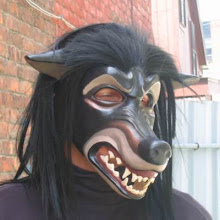So much fun to paint!!
These guys are a major pain to cast. Though the mold is small and there isn't a lot of surface area for me to cover, it takes me a looooong time to get the paper down into all those nooks and crannies and around all those little bends at the edges. It's very slow, meticulous work. It takes me seven to nine hours just to finish a cast and get it ready to paint.
I made one major refinement to my method as I worked on these. I sealed the edges of the masks with... coffee filters. Since the fronts and backs of my masks are made out of two different kinds of material, I had originally been reluctant to seal the edges with anything but glue, as I had thought any material that would match and blend in with one side of the mask would not with the other. But coffee filters are a truly miraculous kind of paper. When coffee filter strips are applied in torn strips and smoothed down with thinned down glue, they just... vanish. If they're applied well, it's almost impossible to tell they're even there, no matter what surface they're applied to.
Thanks Creaturiste for the tip!!

2 comments:
Thur so perty! I love the Coppery one!
Very neat!
I recently eimplemented a way to speed up the application of the release layer, which later becomes part of the smooth surface.
What I do is apply about two or three layers of toilet paper directly to the mold, and pressing it down with a wet brush (water only). It's super fast. I stop when it's opaque. Then I let it dry or force it to dry, and delicately brush a coat of slightly diluted glue, which is also dried. This prevents the release layer from lifting. Then I proceed with my paper strips as usual.
This only works well (for me so far) if the toilet paper and other layers are overlapping over the edge of the mold part.
When properly dried, it can be pulled out of the mold. The fuzzy surface caused by the pulling of the toilet paper can be smoothed down with slightly diluted glue.
The result is not perfect like plaster, it's more organic, but it has its own appeal.
That's what I used for my recent mouse and Bunny puppets, cast in paper within hot glue molds. It would have worked even better in rubber molds.
Post a Comment